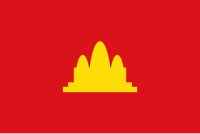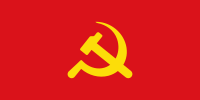| This section needs additional citations for verification. (November 2008) |
Main articles: Democratic Kampuchea and Khmer Rouge rule of Cambodia
Flag of Democratic Kampuchea
Flag of the Communist Party of Kampuchea
The new government sought to completely restructure Cambodian society. Remnants of the old society were abolished and religion was suppressed. Agriculture was collectivised, and the surviving part of the industrial base was abandoned or placed under state control. Cambodia had neither a currency nor a banking system.
Democratic Kampuchea's relations with Vietnam and Thailand worsened rapidly as a result of border clashes and ideological differences. While communist, the CPK was fiercely nationalistic, and most of its members who had lived in Vietnam were purged. Democratic Kampuchea established close ties with the People's Republic of China, and the Cambodian-Vietnamese conflict became part of the Sino-Soviet rivalry, with Moscow backing Vietnam. Border clashes worsened when the Democratic Kampuchea military attacked villages in Vietnam. The regime broke off relations with Hanoi in December 1977, protesting Vietnam's alleged attempt to create an Indochina Federation. In mid-1978, Vietnamese forces invaded Cambodia, advancing about 30 miles (48 km) before the arrival of the rainy season.
The reasons for Chinese support of the CPK was to prevent a pan-Indochina movement, and maintain Chinese military superiority in the region. The Soviet Union supported a strong Vietnam to maintain a second front against China in case of hostilities and to prevent further Chinese expansion. Since Stalin's death, relations between Mao-controlled China and the Soviet Union had been lukewarm at best. In February to March 1979, China and Vietnam would fight the brief Sino-Vietnamese War over the issue.
In December 1978, Vietnam announced the formation of the Kampuchean United Front for National Salvation (KUFNS) under Heng Samrin, a former DK division commander. It was composed of Khmer Communists who had remained in Vietnam after 1975 and officials from the eastern sector—like Heng Samrin and Hun Sen—who had fled to Vietnam from Cambodia in 1978. In late December 1978, Vietnamese forces launched a full invasion of Cambodia, capturing Phnom Penh on 7 January 1979 and driving the remnants of Democratic Kampuchea's army westward toward Thailand.
Within the CPK, the Paris-educated leadership—Pol Pot, Ieng Sary, Nuon Chea, and Son Sen—were in control. A new constitution in January 1976 established Democratic Kampuchea as a Communist People's Republic, and a 250-member Assembly of the Representatives of the People of Kampuchea (PRA) was selected in March to choose the collective leadership of a State Presidium, the chairman of which became the head of state.
Prince Sihanouk resigned as head of state on 4 April. On 14 April, after its first session, the PRA announced that Khieu Samphan would chair the State Presidium for a 5-year term. It also picked a 15-member cabinet headed by Pol Pot as prime minister. Prince Sihanouk was put under virtual house arrest.


No comments:
Post a Comment